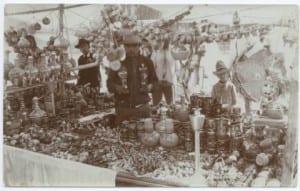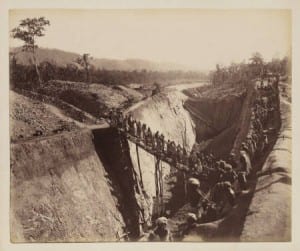“The Cotton Ground Colaba, Bombay” taken by William Johnson and William Henderson in the mid-19th century displays mass quantities of cotton harvested. The amount of cotton grouped together, seemingly getting ready to export, is immense. There are little hut-like structures with ladders leading up to them with many harvesting tools laying around. The grounds are absolutely desolate in regards to people. Buildings surround the bundles of cotton that are relatively new given the European style architecture. The larger buildings to the right could possibly be a factory since the photo is taken after the Industrial Revolution. What catches the eye is the magnitude of the grounds. It gives a visual representation of how the Europeans exploit the Indians for their raw materials. These mounds of cotton were most likely exported to Europe immediately so they could be factory made into valuable products. On the other hand, maybe the Europeans kept a certain amount for the Indians to produce native calico textiles to be sold in Europe. The absence of people is a puzzling matter. The grounds are large and filled with all harvested cotton but no one is there to transport it. This brings up the debate whether or not these raw materials will be exported or produced in India.
http://digitalcollections.smu.edu/cdm/singleitem/collection/eaa/id/1092/rec/115
“Fancy Pottery Venders” taken by C.B. Waite in 1905 displays a pottery stand in a traditional Mexican market. In the stand there are five people. The first and most noticeable is a man holding two figurines wearing fairly nice clothes and a wide-brimmed hat. He is grimacing at the photographer. The second two noticeable people are two young boys, one who seems to be in his late teens and the other a child. Both of these boys are dressed nicely and wearing similar hats to the elderly man. The last two figures in the photo are somewhat hidden, there is a body behind the oldest man and a woman hidden behind some of their pottery in the back corner. Their merchandise is mostly intricately decorated pottery and figurines with traditional artwork on the surface of each product. This stand speaks a lot about Mexican culture. All of the materials displayed seem to be traditional pieces that in some way relate to Mexican views, beliefs, or customs. The reason for the venders’ disdain may be due to their disapproval of foreigners and the possibility of those foreigners tampering or mishandling the “fancy” traditional art.
http://digitalcollections.smu.edu/cdm/singleitem/collection/mex/id/500/rec/116

















